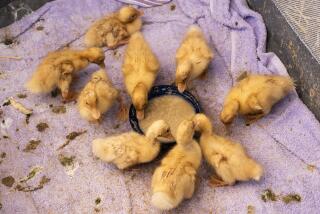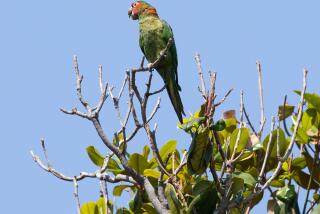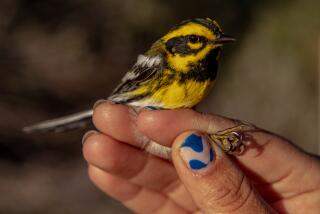COLUMN ONE : It’s ‘Father Goose’ to the Rescue : A stubborn Canadian, with some help, is putt-putting through the skies hoping to reinstill in the endangered trumpeter swan the instinct to migrate south.
- Share via
BLACKSTOCK, Canada — Almost 300 years ago, trumpeter swans were so abundant in North America that fur trader Antoine Laumet Cadillac, approaching the shore in his pirogue near what is now Detroit, mistook their stately masses for a profusion of waterlilies.
Soon afterward, alas, someone noticed what good pens the quills of the trumpeter swan made, and a great swan kill-off began. By 1932, there were only 70 trumpeters left in the United States.
Today, the trumpeter swan has made a faltering comeback in remote parts of North America, but even this modest rebound is imperiled by the bird’s inability to migrate to its wintering grounds in the eastern United States.
If quill fanciers and hunters failed to wipe out the swan altogether, their depredations did erase the bird’s knowledge of migration routes, which had been passed on through eons from parent to cygnet.
And so it is today that when ornithologists try to repopulate the species by releasing trumpeters into the wild, the birds fly off in all directions. Some get lost, some get shot, some go north for the winter and starve. The clever ones get on by hanging around the warm-water waste pools of power plants.
“When they’re not raised by their natural parents, they’re morons,” Harry Lumsden, a retired Ministry of Natural Resources biologist, said with a sigh.
Lumsden has spent a decade trying to re-establish trumpeter swans in Ontario. One good epidemic at one of those sheltering power plants, he said, and a sizable percentage of the trumpeter population worldwide would be lost.
David Weaver, executive secretary of the Minnesota-based Trumpeter Swan Society, said: “The problem is such that we need to consider everything that comes along, no matter how ludicrous it may sound.”
Mother Nature, meet Father Goose.
On warm summer days, 51-year-old Bill Lishman can be seen in the skies of southern Ontario, skimming over cornfields and pasturelands with a perfect chevron of gray and black Canada geese honking along behind him. Lishman has trained the geese to fly in formation with his homemade ultralight aircraft, after three arduous years of trial and error, busted wings and broken feet.
Now, with the help of Canadian naturalist Bill Carrick, Lishman hopes to take trumpeter swans to the air lanes. If the two men succeed in training the trumpeters to fly with the ultralight, they will then guide the rare birds back to their wintering places on Chesapeake Bay, re-establishing the migration of old.
“The theory is extremely sound,” said William Sladen, professor emeritus of immunology and infectious diseases at Johns Hopkins University and an authority on swans and their migratory habits. “We believe the ultralight is the answer.”
On 100 acres of fallow pastureland and pine groves here, northeast of Toronto, Lishman has for three years been keeping gaggles of goslings in pens by the side of a grassy airstrip. By day, in early summer, Lishman jogs up and down the runway with his fluffy goslings in hot pursuit. Lishman swings a tape recorder on a strap as he runs, blaring the sound of an ultralight engine at full throttle. By night, Lishman beds the goslings down under the wing of his parked ultralight. His neighbors call him Father Goose.
“Geese need a lot of mothering,” Lishman explained. “The more attention you pay to them, the more they’ll stick with you. You can’t just spend five minutes with them in the morning and five minutes at night.”
By running with the baby geese at least three times a day, every day, he says, he accustoms them to the engine’s roar, and to his strange, human form.
Lishman is motivated, he says, by a dream he has had since childhood of flying with the birds. He was born in 1939 to a biologist mother and a fighter-pilot-trainer father, who raised him on a steady diet of daring-young-man stories featuring the pilots of Spitfires and Hawker Hurricanes in wartime Europe.
When peace came, the Lishman family settled down on a farm. Young Bill would spend hours watching the seagulls that trailed after his father’s plow, daydreaming about fighter planes. As soon as he was old enough, Lishman enrolled in the Canadian Air Cadets, but it turned out he was colorblind, and a medical panel declared him ineligible to fly. Lishman grew up to become a successful sculptor, but he never abandoned his dream of flying with the birds. When the first crude hang gliders emerged, in the early 1970s, he bought one, added an engine, and began experimenting on a hill behind his house.
While all this was going on in Blackstock, Carrick--himself a World War II pilot--had begun making nature movies.
“I enjoy animals and being outdoors, and I could never figure out why nobody else does,” he said, slogging from pond to pond during an interview on a marshy, nine-acre nature preserve he keeps just outside of Toronto.
In 1973, Carrick got a contract to provide the animals for a film about “Gray Owl,” a British naturalist who lived with Indians in the Canadian wild and wrote vividly about the antics of beavers. Carrick introduced half a dozen beavers to his preserve and, for realism’s sake, threw in assorted waterfowl. He even built a wind tunnel for the birds to fly in on camera, and he set about “imprinting” the ducks, geese and beavers that would star in the film.
“Imprinting” is a technique developed by Konrad Lorenz, the Nobel Prize-winning Austrian pioneer of ethology, the study of animal behavior. Lorenz, who kept a houseful of fish, fowl and wild animals, observed that baby birds instinctively followed the first large creature that moved away from them after they hatched. The hatchlings formed a parental bond with that creature, he wrote, “imprinting” themselves upon it.
Carrick, an admirer of Lorenz, adopted the Austrian’s technique to get his geese up and flying in the wind tunnel. His children amused themselves by training the imprinted geese to fly behind their bicycles. One goose even took to flying behind a friend’s car, Carrick says. A local newspaper told of these goings-on, and the wishful Lishman read of them excitedly.
“He called me up,” Carrick recalled. “He said he’d been flying for years and years. He asked me if geese would follow an airplane. I said, ‘No reason why not.’ ”
Soon, the two men had formed a loose partnership.
The first summer, Lishman imprinted a dozen geese to fly behind his motorcycle, assuming they would make an easy transition to the ultralight. He assumed incorrectly: In one early experiment, a goose hit the ultralight’s propeller, breaking the prop and splintering the bird’s wing. The next spring, Lishman started over with a fresh batch of goslings, and a redesigned, goose-friendly aircraft. But this time, on the maiden flight, a carburetor valve stuck, the engine stalled, and Lishman tumbled into a ditch and broke his foot. He spent six weeks in a cast.
The third year, Lishman designed and built yet another ultralight and imprinted yet another gaggle of goslings. Each day, he said, he hauled himself out of bed before sunrise, fed the geese, ran with them and played the sound of the ultralight engine for them. He would taxi up and down the airstrip, the birds flapping along behind.
Finally, one day, he decided the birds were ready to fly. He taxied down the airstrip, revved the engine a few times to attract the geese’s attention and opened the throttle as they burst out of the gate. Lishman pulled up, executed a 90-degree turn and looked back to see the geese far below, flapping madly in an effort to catch up. He eased back to 20 m.p.h., just above stalling speed, and the geese came up alongside, forming a ragged chevron off his wing.
Below, on the ground, his wife and children cheered. A friend filmed the scene with a video camera, making what was to be an award-winning documentary that will be shown at the National Educational Film and Video Festival, in San Francisco, on May 26.
Meanwhile, back at his preserve, Carrick was spinning more ideas. A member of the Trumpeter Swan Society, he knew the difficulties swan lovers were having in restoring trumpeters to their native habitat. As the trumpeter swan had died out, it had been replaced with mute swans imported from Europe, “the ones you see in parks and on toilet paper,” Carrick sniffed.
To the uninitiate, mute swans may make a lovely sight, but North American bird lovers consider them an unacceptable substitute for the trumpeters. Mute swans, by definition, lack the trumpeter’s sonorous call; they hiss a lot. They are also aggressive, known to catch goslings and ducklings and make a meal of them.
Ontario, and some American states, have been running discreet programs to dethrone the mute swan and bring back the trumpeter. They send field workers to find mute swan nests, take out the eggs, shake them to kill the embryos, and return them, along with a few trumpeter eggs, to the nests. The idea is to make the mute swans unwitting foster parents to the baby trumpeters.
This gambit doesn’t always work. Trumpeter eggs, for one thing, cost $200 apiece, and they don’t always hatch. Then, the white hatchling trumpeters have to be caught by biologists and dyed the dusky color of mute cygnets, so the “parents” don’t reject them.
Finally, if the trumpeters are lucky enough to reach maturity, there is no one to teach them the old migration routes.
Knowing all this, Carrick got to thinking that as long as Lishman had trained geese to fly with his aircraft, he might just as well train trumpeter swans and guide them to safe wintering grounds. When he told Lishman his plan, the sculptor was inspired.
Now, Lishman is building a new ultralight that will take off and land on floats, since swans, unlike geese, must take off from water. Carrick began working out with trumpeter cygnets and a motorboat last year. Sladen, the Johns Hopkins swan man, is looking for financial backing and has found a safe wintering spot for the first batch of birds, on the grounds of a conference center near Washington.
Lishman plans to make a dry run with Carrick’s dime-a-dozen geese later this summer, and if all goes well, he, Carrick, and a ground crew will embark with the precious swans in the fall.
“You have to be very careful,” Lishman said. “With trumpeters, it’s a whole different ball game. Trumpeters fly much later in the year, so late in the season that we might not get the weather (we need). You can’t fly ultralights in rough weather.
“And when the trumpeters first learn to fly, they’re much more awkward than geese. You could have a mid-air with one of them very easily.”
But Lishman noted that it should take only one successful trip with the ultralight to show the birds the way south. After that, the swans will be on their own, and he can return to full-time sculpting.
Lovers of the trumpeter swan might argue that Lishman’s airborne exertions as the man who teaches birds to fly are themselves art of a high order.
“Surely the best art is always functional,” says Lumsden, the trumpeter swan restoration expert.
More to Read
Sign up for Essential California
The most important California stories and recommendations in your inbox every morning.
You may occasionally receive promotional content from the Los Angeles Times.













